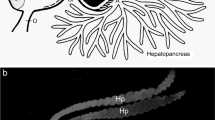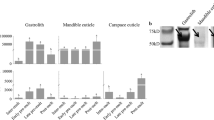Abstract
This study examines the following in the Japanese mitten crab: (1) the structure of the exoskeleton with special reference to its calcification; (2) the progression of post-molt cuticle formation and calcification. In the crab, the structure and calcification state of the exoskeleton at the molt and during the inter-molt stage were similar to those of other crustaceans. During the inter-molt, the exoskeleton consisted of four cuticle layers; the outermost epicuticle, the exocuticle, the endocuticle and the innermost membrane layer. Intense calcification was observed in the exo- and endocuticle. At the molt, the synthesis of the epi- and exocuticle was already complete, and the addition of the endocuticle began after the molt. Calcification of the exocuticle initiated soon after the molt, but there was a delay between endocuticle matrix synthesis and calcification. Histology showed that the process of calcification was similar to that in other crustaceans. However, calcium concentrations within the exoskeleton continued to increase and never reached the levels of the inter-molt stage at the end of the experiment. This suggests that the Japanese mitten crab is relatively slow to calcify compared to other crustaceans.




Similar content being viewed by others
References
Kobayashi S, Matsuura S (1995) Japanese mitten crab. In: Fisheries Agency (ed) Basic data about rare Japanese wild aquatic organisms II. Japan Fisheries Resource Conservation Association, Tokyo, pp 649–656
Honto W, Iguchi M (2003) Regional science promotion program (RSP): development of a culture system of Japanese mitten crab. Bull Yamagata Pref Fish Exp Stn H13:73–74
Passano LM (1960) Molting and its control. In: Waterman TH (ed) The physiology of Crustacea. Volume 1: metabolism and growth. Academic, New York, pp 473–527
Travis DF (1963) Structural features of mineralization from tissue to macromolecular levels of organization in the decapod Crustacea. Ann N Y Acad Sci 109:177–245
Roer R, Dillaman R (1984) The structure and calcification of the crustacean cuticle. Am Zool 24:893–909
Kleinholz LH (1941) Molting and calcium deposition in decapod crustaceans. J Cell Comp Physiol 18:101–107
Welinder BS (1975) The crustacean cuticle II. Deposition of organic and inorganic material in the cuticle of Astacus fluviatilis in the period after moulting. Comp Biochem Physiol 51B:409–416
Huner JV, Kowalczuk JG, Avalut JW Jr (1978) Postmolt calcification in subadult red swamp crayfish, Procambarus clarkii (Girard) (Decapoda, Cambaridae). Crustaceana 34:275–280
Huner JV, Benard Colvin L, Reid BL (1979) Postmolt mineralization of the exoskeleton of juvenile California brown shrimp, Penaeus californiensis (Decapoda: Penaidae). Comp Biochem Phsyiol 62A:889–893
Huner JV, Benard Colvin L, Reid BL (1979) Whole body calcium, magnesium and phosphorus levels of the California brown shrimp, Penaeus californiensis (Decapoda: Penaidae) as functions of molt cycle. Comp Biochem Phsyiol 64A:33–36
Brannon AC, Ranga Rao K (1979) Barium, strontium and calcium levels in the exoskeleton, hepatopancreas and abdominal muscle of the grass shrimp, Palaemonetes pugio: relation to molting and exposure to barite. Comp Biochem Physiol 63A:261–274
Vigh DA, Dendinger JE (1982) Temporal relationships of postmolt deposition of calcium, magnesium, chitin and protein in the cuticle of the Atlantic blue crab, Callinectes sapidus Rathbun. Comp Biochem Physiol 72A:365–369
Pratoomchat B, Sawangwong P, Pakkong P, Machado J (2002) Organic and inorganic compound variations in haemolymph, epidermal tissue and cuticle over the molt cycle in Scylla serrata (Decapoda). Comp Biochem Physiol Part A 131:243–255
Giraud-Guille M-M, Quintana C (1982) Secondary ion microanalysis of the crab calcified cuticle: distribution of mineral elements and interactions with the cholesteric organic matrix. Biol Cell 44:57–68
Greenaway P (1983) Uptake of calcium at the postmoult stage by the marine crabs Callinectes sapidus and Carcinus maenas. Comp Biochem Physiol 75A:181–184
Cameron JN (1985) Postmolt calcification in the blue crab (Calinectes sapidus): relationships between apparent net H+ excretion, calcium and bicarbonate. J Exp Biol 119:275–285
Rukke NA (2002) Effect of low calcium concentrations on two common freshwater crustaceans, Gammarus lacustris and Astacus astacus. Function Ecol 16:357–366
Perry H, Trigg C, Larsen K, Freeman J, Erickson M, Henry R (2001) Calcium concentration in seawater and exoskeletal calcification in the blue crab, Callinectes sapidus. Aquaculture 198:197–208
Giraud-Guille M-M (1984) Calcification initiation sites in the crab cuticle: the interprismatic septa. Cell Tissue Res 236:413–420
Inoue H, Ohira T, Ozaki N, Nagasawa H (2003) Cloning and expression of a cDNA encoding a matrix peptide associated with calcification in the exoskeleton of the clayfish. Comp Biochem Physiol Part B 136:755–765
Inoue H, Ohira T, Ozaki N, Nagasawa H (2004) A novel calcium-binding peptide from the cuticle of the clayfish, Procambarus clarkii. Biochem Biophys Res Commun 318:649–654
Inoue H, Ozaki N, Nagasawa H (2001) Purification and structural determination of a phosphorylated peptide with anti-calcification and chitin-binding activities on the exoskeleton of the crayfish, Procambarus clarkii. Biosci Biotechnol Biochem 65:1840–1848
Endo H, Persson P, Watanabe T (2000) Molecular cloning of the crustacean DD4 cDNA encoding a Ca2+-binding protein. Biochem Biophys Res Commun 276:286–291
Endo H, Takagi Y, Ozaki N, Kogure T, Watanabe T (2004) A crustacean Ca2+-binding protein with a glutamate-rich sequence promotes CaCO3 crystallization. Biochem J 384:159–167
Acknowledgments
This study was partly supported by a Yamagata Prefecture Industry–Academia–Government Collaboration Grant, and a twenty-first century COE Program awarded by the Ministry of Education, Culture, Sports, Science, and Technology, Japan. Thanks are due to Ms. M. Hasegawa, Ms. C. Nishida and Ms. E. Sasagawa for their technical assistance.
Author information
Authors and Affiliations
Corresponding author
Rights and permissions
About this article
Cite this article
Sakamoto, K., Honto, W., Iguchi, M. et al. Post-molt processes of cuticle formation and calcification in the Japanese mitten crab Eriocheir japonicus . Fish Sci 75, 91–98 (2009). https://doi.org/10.1007/s12562-008-0003-y
Received:
Accepted:
Published:
Issue Date:
DOI: https://doi.org/10.1007/s12562-008-0003-y




